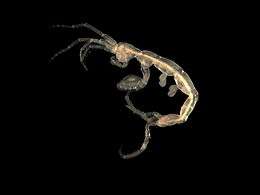Caprellidira
Caprellidira is a parvorder of marine crustaceans of the infraorder Corophiida. The group includes skeleton shrimps (Caprellidae) and whale lice (Cyamidae).
| Caprellidira | |
|---|---|
 | |
| Pariambus typicus | |
| Scientific classification | |
| Kingdom: | Animalia |
| Phylum: | Arthropoda |
| Subphylum: | Crustacea |
| Class: | Malacostraca |
| Superorder: | Peracarida |
| Order: | Amphipoda |
| Suborder: | Senticaudata |
| Infraorder: | Corophiida |
| Parvorder: | Caprellidira Leach, 1814 [1] |
| Families | |
|
See text | |
Fifteen families are currently recognised in the group. They are grouped into seven superfamilies.[2][3][4]
- Superfamily Aetiopedesoidea Myers & Lowry, 2003
- Aetiopedesidae Myers & Lowry, 2003
- Paragammaropsidae Myers & Lowry, 2003
- Superfamily Caprelloidea Leach, 1814
- Caprellidae Leach, 1814 - Skeleton shrimps
- Caprogammaridae Kudrjaschov & Vassilenko, 1966
- Cyamidae Rafinesque, 1815 - Whale lice
- Dulichiidae Laubitz, 1983
- Podoceridae Leach, 1814
- Superfamily Isaeoidea Dana, 1853
- Isaeidae Dana, 1853
- Superfamily Microprotopoidea Myers & Lowry, 2003
- Microprotopidae Myers & Lowry, 2003
- Superfamily Neomegamphopoidea Myers, 1981
- Neomegamphopidae Myers, 1981
- Priscomilitariidae Hirayama, 1988
- Superfamily Photoidea Boeck, 1871
- Ischyroceridae Stebbing, 1899
- Kamakidae Myers & Lowry, 2003
- Photidae Boeck, 1871
- Superfamily Rakirooidea Myers & Lowry, 2003
- Rakiroidae Myers & Lowry, 2003
References
- "Caprellidira Leach, 1814". Integrated Taxonomic Information System. Retrieved March 4, 2011.
- Claude De Broyer (2011). Lowry J (ed.). "Caprellida". World Amphipoda database. World Register of Marine Species. Retrieved August 31, 2011.
- Sara E. LeCroy (2007). "Appendix II: Revised Classification of the Corophiidea". An Illustrated Identification Guide to the Nearshore Marine and Estuarine Gammaridean Amphipoda of Florida. Volume 4: Families Anamixidae, Eusiridae, Hyalellidae, Hyalidae, Iphimediidae, Ischyroceridae, Lysianassidae, Megaluropidae, and Melphidippidae. Florida Department of Environmental Protection. p. 612.
- A. A. Myers & J. K. Lowry (2003). "A phylogeny and a new classification of the Corophiidea Leach, 1814 (Amphipoda)". Journal of Crustacean Biology. 23 (2): 443–485. doi:10.1651/0278-0372(2003)023[0443:APAANC]2.0.CO;2. JSTOR 1549648.
External links


This article is issued from Wikipedia. The text is licensed under Creative Commons - Attribution - Sharealike. Additional terms may apply for the media files.